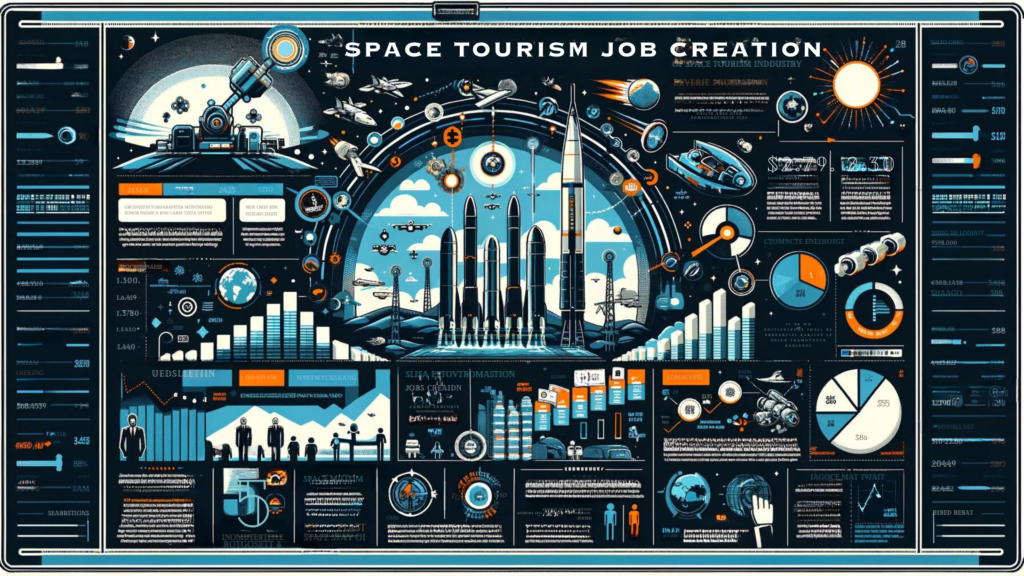Welcome to the third part of our Blog Series – “Space Tourism: Economy & Market Unveiled“.
As we embark on the next installment of our series, we dive into the vibrant economic landscape of space tourism, an arena that promises not just celestial adventures but a galaxy of financial opportunities and challenges. This sector, once a mere figment of science fiction, is rapidly evolving into a significant industry with the potential to revolutionize how we view, engage with, and ultimately, commercialize space.
The Economic Frontier
The journey into the economic aspects of space tourism uncovers a terrain rich with potential for growth, innovation, and job creation. As the industry propels from the pages of science fiction into reality, spearheaded by visionaries at SpaceX, Virgin Galactic, and Blue Origin, it heralds a new era of economic possibilities.

These companies are at the vanguard, crafting not merely an experience but an entire ecosystem that could support a wide array of jobs — from engineers and scientists developing spacecraft to service staff in space hotels, and even educators and trainers preparing tourists for their journeys.
Beyond direct employment, the ripple effects of this emerging industry are poised to stimulate growth in related sectors, including manufacturing, technology, and tourism, showcasing space tourism’s role as a catalyst for broad economic development. This frontier is not just about reaching new heights in space but also about elevating the economic landscape on Earth, turning the vastness of space into a field of opportunity for innovation, entrepreneurship, and global collaboration.
Market Demand and Accessibility
At the heart of space tourism’s economic landscape lies the pivotal issue of market demand and accessibility. The allure of space travel is universal, yet its reach has been confined by the towering costs associated with venturing into space. Initially, the staggering prices have limited space tourism to the wealthiest individuals, casting it as the ultimate luxury experience.

However, the trajectory of the industry is bending towards greater accessibility, driven by advancements in technology, increased competition, and economies of scale. As these factors converge to lower costs, space tourism inches closer to a broader audience, promising a future where space travel could become a component of mainstream tourism. This democratization process is crucial, not only for expanding the market but also for fostering a more inclusive vision of space exploration.
As accessibility improves, the industry faces the challenge of scaling operations while maintaining safety and sustainability, navigating the delicate balance between opening the final frontier to all and preserving the integrity of space and Earth’s environment. The evolution of market demand and accessibility encapsulates the dynamic interplay between human aspiration, technological innovation, and economic principles, charting the course for space tourism’s future.
Price Sensitivity and Consumer Interest
The dynamics of price sensitivity play a crucial role in shaping the future of space tourism, intricately linked with consumer interest and the potential for widespread participation. As the industry strides forward, the question of affordability comes into sharp focus. High costs have historically confined space travel to a select group of wealthy adventurers, but a shift is on the horizon.

Consumers from various walks of life express a keen interest in space tourism, tethered to the dream of floating among the stars. This enthusiasm, however, is tempered by the reality of price tags, making it clear that the market’s expansion hinges on making space travel more financially accessible. Surveys and studies have begun to shed light on the price points at which a larger segment of the population would consider such trips, revealing a broad spectrum of interest that could be tapped into with the right pricing strategies.
This sensitivity to cost underscores a pivotal challenge for companies: innovating to reduce expenses without compromising the safety and awe-inspiring quality of the space experience. As prices edge downward, the dream of space tourism could transition from a once-in-a-lifetime luxury to a more commonly pursued adventure, broadening the industry’s consumer base and fueling further growth and development.
Challenges and Opportunities
The path to commercializing space tourism is laden with both challenges and opportunities, each shaping the trajectory of the industry. On one hand, the technical and safety challenges of transporting civilians beyond Earth’s atmosphere demand rigorous attention and innovation.
On the other hand, these challenges present unique opportunities for growth and advancement. The pursuit of safer, more efficient space travel drives technological innovation, not just within the space industry, but across multiple sectors, potentially leading to breakthroughs in materials science, propulsion systems, and sustainable energy sources.

Developing spacecraft that are both reliable and reusable is a monumental task, requiring significant investment in research and development. Moreover, ensuring the safety of space tourists adds another layer of complexity, as companies must adhere to stringent standards to prevent accidents and ensure a positive experience for all travelers.
Furthermore, the growing interest in space tourism fosters international collaboration and regulatory development, setting the stage for a new era of global space governance. As the industry navigates these hurdles, it stands to not only open up the final frontier to humanity but also to catalyze economic growth, inspire future generations, and contribute to our comprehension of the cosmos and our role in it.
What to Expect Next?
As we look to the future, the economic implications of space tourism extend far beyond the immediate industry. From the creation of new jobs and industries to the stimulation of technological innovation and global cooperation, space tourism holds the promise of a new economic frontier. Stay tuned for our next post, where we’ll delve deeper into the historical context and prospects of space tourism, exploring how this industry could shape the future of human space exploration and economic growth.
Author’s Note
In this series, we aim to peel back the layers of space tourism, revealing not just the technological marvels but the economic and societal implications of this groundbreaking industry. As we continue our exploration, we invite you to join us in contemplating the vast potential of space tourism, both as a frontier for human adventure and as a catalyst for economic and technological advancement.
G.C., Ecosociosphere contributor.
References and Further Reading:





Comments
Your article helped me a lot, is there any more related content? Thanks!
Can you be more specific about the content of your article? After reading it, I still have some doubts. Hope you can help me.
Your article helped me a lot, is there any more related content? Thanks!